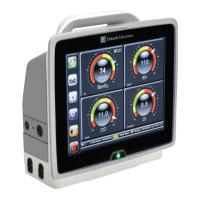31
HemoSphere Advanced Monitor 2 Safety and Symbols
• Accessory equipment connected to the monitor must be certified according to IEC/EN 60950 for
data-processing equipment or IEC 60601-1:2005/A1:2012 for electromedical equipment. All
combinations of equipment must be in compliance with IEC 60601-1:2005/A1:2012 systems
requirements. (chapter 6)
• When switching to a different bedside monitor, always check that the default values listed are still
valid. If necessary, reconfigure the voltage range and corresponding parameter range or calibrate.
(chapter 6)
• Do not turn off the audible alarms in situations in which patient safety could be compromised.
(chapter 7)
• Do not lower the alarm volume to a level that prohibits alarms from being adequately monitored.
Failure to do so could result in a situation where patient safety is compromised. (chapter 7)
• Visual and audible physiological alarms are activated only if the parameter is configured on the
screens as a key parameter (1-4 parameters displayed in parameter globes). If a parameter is not
selected and displayed as a key parameter, the audible and visual physiological alarms are not
triggered for that parameter. (chapter 7)
• Make sure that Demo Mode is not activated in a clinical setting to ensure that simulated data is not
mistaken for clinical data. (chapter 7)
• Do not use the HemoSphere advanced monitor as part of a Distributed Alarm System. The
HemoSphere advanced monitor does not support remote alarm monitoring/management systems.
Data is logged and transmitted for charting purposes only. (chapter 8)
• CO monitoring should always be discontinued when blood flow around the thermal filament is
stopped. Clinical situations where CO monitoring should be discontinued include, but are not
limited to: • Time periods when a patient is on cardiopulmonary bypass • Partial withdrawal of the
catheter so that the thermistor is not in the pulmonary artery • Removal of the catheter from the
patient (chapter 9)
• PACEMAKER PATIENTS – Rate meters may continue to count the pacemaker rate during
occurrences of cardiac arrest or some arrhythmias. Do not rely entirely upon displayed heart rate.
Keep pacemaker patients under close surveillance. See table A-4 on page 191 for disclosure of the
pacemaker pulse rejection capability of this instrument. (chapter 9)
• For patients requiring internal or external pacing support, the HemoSphere advanced monitoring
platform should not be used to obtain heart rate and heart rate derived parameters under the
following conditions: • pacer pulse synch output from bedside monitor includes the pacer pulse,
however, the characteristics are outside of the pacemaker pulse rejection capabilities specifications
as listed in table A-4. • pacer pulse synch output characteristics from bedside monitor cannot be
determined (chapter 9)
• Note any discrepancies in heart rate (HRavg) with the patient monitor HR and ECG waveform
display when interpreting derived parameters such as SV, EDV, RVEF, and associated index
parameters. (chapter 9)
• Do not resterilize or reuse any FloTrac sensor, FloTrac IQ sensor, TruWave transducer, or catheter;
refer to the catheter’s “directions for use”. (chapter 10)
• Do not use a FloTrac sensor, FloTrac IQ sensor, TruWave transducer, or catheter that is wet,
damaged, or that has exposed electrical contacts. (chapter 10)
Status = Released Printed Date: 2018-01-16 Released Date: 2017-09-14

